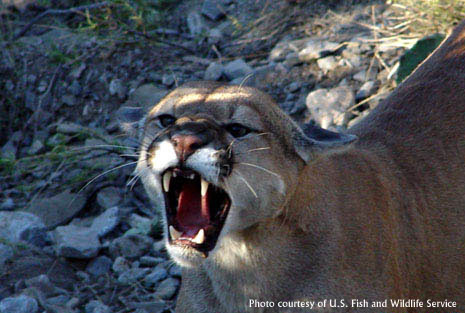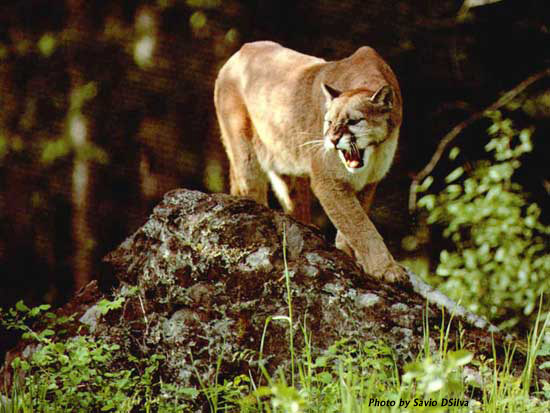"What's for dinner ma?"
Nutrition
|
|
 Cougars do not make loud or deep roaring noises like other large felids. Instead they make a hissing or screaming noise. Click on the following link to hear a cougar "roar" Cougar growling.WAV |
Cougars are carnivorous, meaning they eat flesh, and they typically feed on a
diet primarily consisting of
deer.
Cougars are also known to eat elk, hares, rabbits, porcupines, raccoons,
beavers, muskrats and sometimes livestock. Unfortunately, there have been few
cases in which cougars eat other cougars-sometimes even their own cubs. Cougars are
relatively successful because they use their claws and powerful
 jaw to conquer
their prey, however, they often have to stalk their prey many times before
becoming successful.
Generally, a
cougar kills a large animal once every 12 to 14 days depending on the nutritional
substance of its last prey. The caloric intake of a female cougar is about 3,000
calories per day but this number increases when a cougar is pregnant. After
capturing its prey, a cougar’s first meal is usually the heart, the lungs, and
the liver which prove to be a cougar’s only source of vitamin A. Female cougars
with kittens, especially when they are nearing the age of 2, place higher demand
on the base of prey.
Cougars are
not selective when they attack their prey so instead of only killing the young
and old, they attack animals that leave themselves most open to attack.
jaw to conquer
their prey, however, they often have to stalk their prey many times before
becoming successful.
Generally, a
cougar kills a large animal once every 12 to 14 days depending on the nutritional
substance of its last prey. The caloric intake of a female cougar is about 3,000
calories per day but this number increases when a cougar is pregnant. After
capturing its prey, a cougar’s first meal is usually the heart, the lungs, and
the liver which prove to be a cougar’s only source of vitamin A. Female cougars
with kittens, especially when they are nearing the age of 2, place higher demand
on the base of prey.
Cougars are
not selective when they attack their prey so instead of only killing the young
and old, they attack animals that leave themselves most open to attack.
Home
Classification
Habitat
Reproduction
Nutrition
Adaptations
Interesting facts
About me
References
Multipleorganisms.net